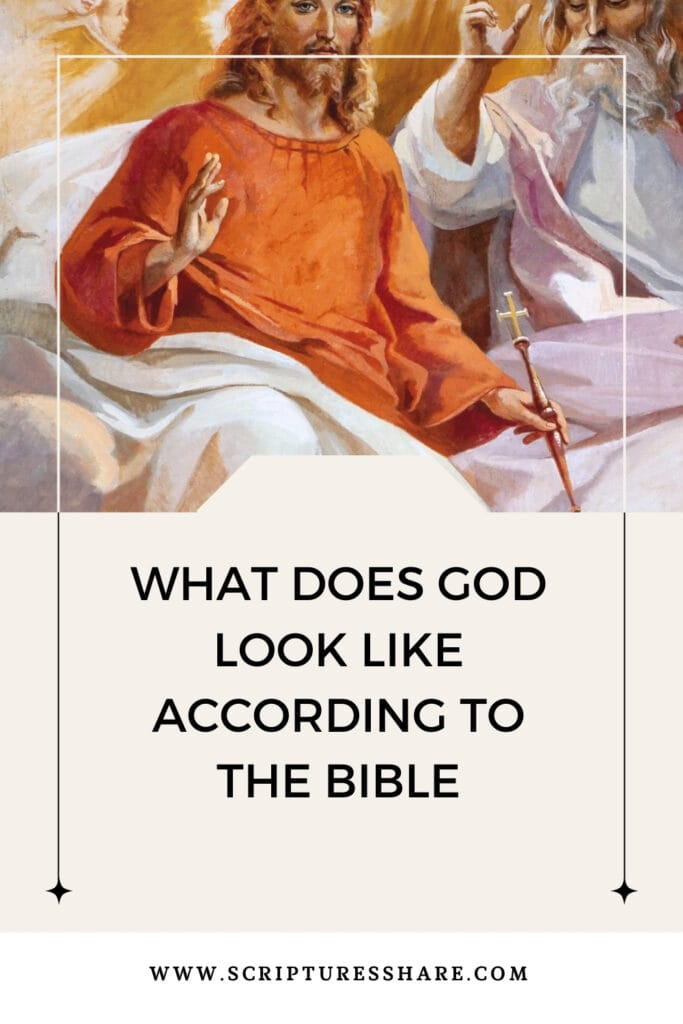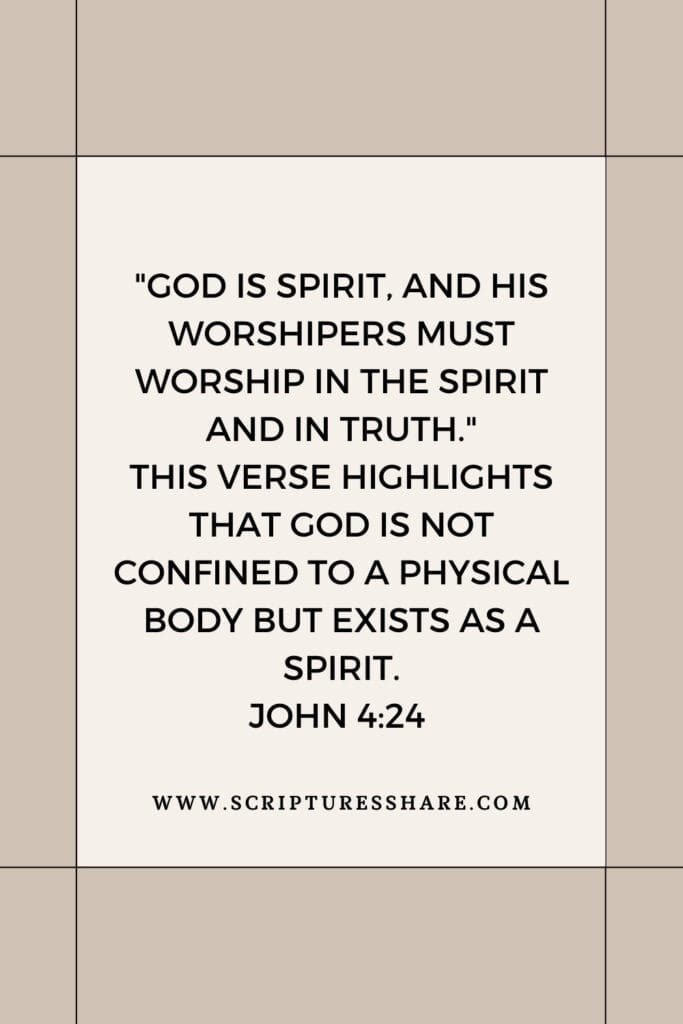No products in the cart.
What Does God Look Like According to the Bible
ADVERTISEMENT
This post contains paid and/or affiliate links. I make a small commission at no extra cost to you. Please see our Privacy Policy.
The Bible doesn’t give a clear, physical look of God. Instead, it uses symbols and images that feel human-like to show God’s power and nature. For example, Ezekiel 1:26-28 and Revelation 1:14-16 talk about God’s glory and power.
They use symbols like a throne made of precious stones and a figure shining brightly. These images aim to make us feel amazed and humble before God, who is beyond what we can fully grasp.
God is seen as a spirit, not something we can see with our eyes (John 4:24, Exodus 33:20). The Bible says we can’t fully understand or describe God’s appearance (1 Timothy 1:17). Yet, it uses human-like traits and images to help us connect with God. This makes God feel closer and more real to us.
God’s Transcendent Nature
The Bible shows us that God’s transcendent nature is not of this world. As a spirit, God doesn’t have a body we can see or touch. This is made clear in John 4:24, which says, “God is spirit, and his worshipers must worship in the Spirit and in truth.”
Also, the Bible tells us that God’s invisible nature is too big for us to fully understand. 1 Timothy 1:17 says God is the “King eternal, immortal, invisible.” This shows how deep the mystery and incomprehensible appearance of God are, going beyond what we can grasp.
“You cannot see my face, for no one may see me and live.” – Exodus 33:20
The Bible teaches us that God’s transcendent nature as a spirit is key to understanding God. It tells us to respect and admire God deeply because we can’t fully get what God is all about.

Anthropomorphic Descriptions in the Bible
The Bible often uses anthropomorphic descriptions – giving humans traits to God. This helps us understand God’s majesty and power. It’s not meant to be taken as real, but to inspire awe and respect.
In the book of Ezekiel, God is described as a figure like a man, surrounded by bright light and colors (Ezekiel 1:26-28). The book of Revelation also shows Christ with human traits, like white hair and eyes of fire (Revelation 1:14-16).
These biblical imagery for God and human traits used to describe God make God’s nature easier to understand. The symbolism for God’s attributes – like wisdom and radiance – show us God’s true nature. They remind us that God wants to be known by us, even though He is beyond what we can see.
| Anthropomorphic Descriptions | Biblical Reference | Symbolic Meaning |
|---|---|---|
| Figure with the appearance of a man | Ezekiel 1:26-28 | Conveys God’s majesty and glory |
| White hair, flaming eyes, brass feet | Revelation 1:14-16 | Depicts Christ’s wisdom, judgment, and stability |
By using anthropomorphic descriptions of God, the Bible helps us understand God in ways we can relate to. Yet, it also reminds us that God’s true nature is too big for us to fully grasp.
Ezekiel’s Vision of God’s Glory
In the book of Ezekiel, the prophet shares a powerful vision of God’s glory. Ezekiel 1:26-28 describes this amazing encounter. It gives deep insights into symbolic representations of God’s attributes and biblical descriptions of God’s appearance.
Ezekiel’s vision of God shows a throne of sapphire with a man-like figure sitting on it. This figure shines with the glow of glowing metal, as if full of fire. Below the waist, it’s surrounded by fire. The scene is bright, with the radiance of a rainbow all around, showing the majesty and holiness of God.
The symbols in Ezekiel’s vision of God’s glory tell us deep truths about God. The throne of sapphire shows God’s authority and His covenant with His people. The fire and light symbolize God’s transcendent power and divine glory. The rainbow’s glow speaks of His mercy, faithfulness, and the promise of His covenant.
“Above the expanse over their heads was what looked like a throne of sapphire, and high above on the throne was a figure like that of a man. I saw that from what appeared to be his waist up he looked like glowing metal, as if full of fire, and that from there down he looked like fire; and brilliant light surrounded him. Like the appearance of a rainbow in the clouds on a rainy day, so was the radiance around him.”
Ezekiel’s vision of God’s glory is a strong reminder of symbolic representations of God’s attributes and biblical descriptions of God’s appearance. These vivid images show the majesty and holiness of God. They invite us to be amazed by the Almighty.

John’s Vision of Christ’s Glorified Form
In the book of Revelation, the apostle John shares a vivid vision of the glorified Christ. This vision gives us a deep look into the divine nature and qualities of Jesus.
As told in Revelation 1:14-16, John saw the Son of God with white hair like wool, eyes like blazing fire, feet like bronze glowing in a furnace, and a face shining like the sun in all its brilliance. These images tell us a lot about Christ’s wisdom, judgment, stability, and divine glory.
- The white hair shows Christ’s wisdom and eternal nature, making him the Ancient of Days.
- The flaming eyes show Christ’s sharp judgment and his power to see deep into people’s hearts.
- The bronze feet stand for Christ’s strong stability and steadfastness, being the solid base of the church.
- The radiant countenance talks about Christ’s unmatched glory and divine majesty, showing God’s invisible nature.
John’s vision of Jesus’ glorified form shows the unmatched power, authority, and divine nature of Christ. The symbols used strongly show the wisdom, judgment, stability, and glory of the Son of God.
Bible Verse Finder
Search Results:
ADVERTISEMENT
function displayResults(data) { const resultsContainer = document.getElementById('results'); resultsContainer.innerHTML = '';
if (data && data.verses) { data.verses.forEach(verse => { let li = document.createElement('li'); li.textContent = `${verse.book_name} ${verse.chapter}:${verse.verse} - ${verse.text}`; resultsContainer.appendChild(li); }); } else { resultsContainer.innerHTML = '
'; } }
function performSearch() {
const keyword = document.getElementById('searchKeyword').value;
if (keyword) {
searchBible(keyword);
} else {
alert("Please enter a keyword to search");
}
}
What Does God Look Like According to the Bible
The Bible doesn’t give a clear picture of what God looks like. Instead, it uses symbols and images to show God’s nature and qualities. This way, it shows God’s greatness is too big for us to fully understand or see.
In the Bible, stories like Ezekiel 1 and Revelation 1 use symbols like a throne, fire, and light. These symbols make us feel awe and respect for God’s power and beauty. They don’t mean we should see God as these symbols, but they help us grasp His greatness.
Lack of Literal Physical Depiction
The Bible doesn’t give a clear, physical look of God. This is because God is too big for us to fully get or picture. Trying to show God in a physical way would be too simple and not enough.
Symbolic Representations of God
- The Bible uses symbols and images to show God’s nature and qualities.
- Stories like Ezekiel 1 and Revelation 1 use vivid symbols to make us feel awe and respect for God’s greatness.
- These symbols are not meant to be taken as real pictures, but they help us understand God’s big and mysterious nature.
| Biblical Description | Symbolic Representation |
|---|---|
| Throne of sapphire, amber, and fire (Ezekiel 1:26-28) | Shows God’s majesty, holiness, and covenant |
| White hair, flaming eyes, brass feet, radiant countenance (Revelation 1:14-16) | Depicts Christ’s wisdom, judgment, stability, and divine glory |
“God is spirit, and those who worship him must worship in spirit and truth.” (John 4:24)
The Bible’s way of describing God shows us that God is more than just a physical form. By using symbols and images, the Bible invites us to think deeply about God’s amazing nature. It helps us see God’s greatness without trying to limit it to something we can see.
ADVERTISEMENT

The Image of God in Humanity
According to the Bible, humans were made in the image of God. This means we show some parts of God’s nature, like being rational, creative, and able to form deep connections. The Bible doesn’t give a clear look at God’s appearance. Instead, the “image of God” in us is more about our spiritual and moral likeness.
Advertisement. Scroll to continue reading.
Humans were made to reflect God’s character, even though we can’t fully grasp or show God’s true nature. This bond between God and us shows how precious and important every person is. We’re all made in the likeness of the Creator.
Aspects of God’s Nature Reflected in Humanity
- Rationality and intelligence
- Creativity and the ability to shape the world around us
- Relational capacity and the desire for meaningful connections
- Moral awareness and the capacity for righteousness and holiness
ADVERTISEMENT
But sin has marred the image of God in us. Through faith in Jesus Christ, we can be restored and transformed. This lets us better reflect our Creator’s character and live out our purpose as beings made in His likeness.
Evidence of God’s Existence
The Bible doesn’t give us a clear picture of God’s appearance. Yet, it shows us evidence for the existence of God in many ways. The natural world’s design and balance, and our own feelings of the divine, make a strong case for God.
Natural Revelation
The world around us is incredibly complex and harmonious. This suggests an intelligent Creator. The Psalmist says, “The heavens declare the glory of God; the skies proclaim the work of his hands” (Psalm 19:1). Paul also said, “God’s invisible qualities—his eternal power and divine nature—have been clearly seen, being understood from what has been made” (Romans 1:20).
Advertisement. Scroll to continue reading.
Human Experience
People naturally feel a sense or intuition of the divine. This shows we’re aware of something greater than us. Paul said, “even Gentiles, who do not have the law, show that the requirements of the law are written on their hearts” (Romans 2:14-15). This shows our deep longing for something beyond us.
Jesus as Proof of God
The life, teachings, and claims of Jesus Christ are the strongest evidence for God’s existence. Jesus said he was the Son of God and showed us God’s nature (John 8:58, Mark 14:62). Through him, we see parts of God, even if we can’t fully understand God’s full nature.
The evidence from nature, human experience, and Jesus all point to the divine. They invite us to look into the mysteries of the Almighty.

Anthropomorphism in Biblical Descriptions
The Bible uses anthropomorphic language to help us understand God. It gives God human traits, forms, and experiences. This way, God becomes more relatable and easier to grasp.
Advertisement. Scroll to continue reading.
God is described with human-like qualities like hands, eyes, emotions, and actions. These traits show His power, compassion, anger, and how He interacts with the world. The Bible aims to inspire us to worship, respect, and follow God, who is both different and close to us.
God’s true nature is too big for us to fully understand. So, the Bible uses anthropomorphic language in the Bible. It uses human attributes to describe God and makes God relatable through symbolic imagery. This helps us see parts of God through things we can relate to.
| Anthropomorphic Descriptions | Conveyed Attributes of God |
|---|---|
| Hands, arms | Power, strength, action |
| Eyes, ears | Awareness, omniscience |
| Emotions (love, anger, grief) | Relationship, care, justice |
| Movement, actions (walking, speaking) | Involvement, communication |
With this anthropomorphic language, the Bible makes God easier for us to understand. It still keeps God’s mystery and greatness in mind.
God’s Gender
The Bible shows us that God is not male or female like humans are. God is a spiritual being without a body. This means God’s nature goes beyond what we see as male or female. God has qualities of both, showing us that God is more than what we can understand.
God is described in the Bible with many traits, both seen as male and female. God has strength, power, and authority, like a man. Yet, God is also shown as caring, kind, and loving, like a woman. This shows God is beyond what we see as male or female in our world.
God being a spiritual being means we can’t fully understand God’s gender. God’s nature is not trapped by the ideas of male and female we use in our lives. Instead, God’s true nature is bigger than these ideas, showing us a richness that goes beyond simple gender labels.
| Traditionally Male Attributes | Traditionally Female Attributes |
|---|---|
| Strength | Nurturing |
| Power | Compassion |
| Authority | Love |

The Bible shows us God’s nature is more than just male or female. God’s true nature is bigger than what we see as masculine or feminine. God’s essence is full and goes beyond what we can grasp.
Conclusion
The Bible doesn’t give a clear, physical look of God. God’s true nature is too big for us to fully get. Instead, it uses symbols and images to show us God’s qualities and nature.
For example, in Ezekiel 1 and Revelation 1, God and the glorified Christ are shown with symbols like a throne, fire, and light. These symbols aim to make us feel awe and respect for God. Even though humans are made like God, we can’t fully understand or picture God’s true self.
The Bible shows us God’s existence through nature, our feelings, and the life of Jesus. It tells us to honor the God we can’t fully grasp, as seen in Christ. God’s true nature and form are too deep for us to fully understand.
FAQ
What does the Bible say about God’s physical appearance?
The Bible doesn’t give a clear, physical look of God. God is beyond what humans can see or touch. It uses symbols and images to show God’s traits and nature.
How does the Bible describe God’s transcendent nature?
The Bible says God is a spirit, not a physical being. It also says God’s nature is too big for humans to fully understand. This shows God’s true self is beyond what we can see or imagine.
What kind of language does the Bible use to describe God?
Because God is too big for us to fully get, the Bible uses human-like words to describe God. This helps us grasp some of God’s qualities and nature.
What does Ezekiel’s vision of God’s glory reveal?
Ezekiel 1:26-28 describes a powerful vision of God’s glory. It uses symbols like a throne, a human-like figure, fire, and bright light. These symbols show God’s greatness, holiness, and special bond with us.
How does the book of Revelation describe the glorified Christ?
Revelation 1:14-16 uses symbols like white hair, fiery eyes, brass feet, and a glowing face to show the majesty and power of the risen Christ. Christ is seen as the visible sign of the invisible God.
If the Bible doesn’t describe God’s physical appearance, how do we know what God looks like?
The Bible says humans were made “in the image of God”. This means we reflect God’s nature in ways like being rational, creative, and able to connect with others. But this isn’t about looking like God, it’s about being spiritually and morally like Him.
What evidence does the Bible provide for the existence of God?
The Bible points to the world around us, our deep sense of something greater, and the life and teachings of Jesus as proof of God’s existence. Even though we can’t fully understand God, these signs show God is real.
How does the Bible use anthropomorphic language to describe God?
The Bible gives God human-like traits like hands, eyes, feelings, and actions. This is to show God’s strength, kindness, anger, and role in the world. These images are not meant to be taken as real, but help us understand God’s vastness and mystery.
Does the Bible depict God as having a gender?
The Bible says God is not male or female in the way humans are. God is a spirit without a body. God’s nature goes beyond human gender, showing both male and female qualities.
Source Links
ADVERTISEMENT













